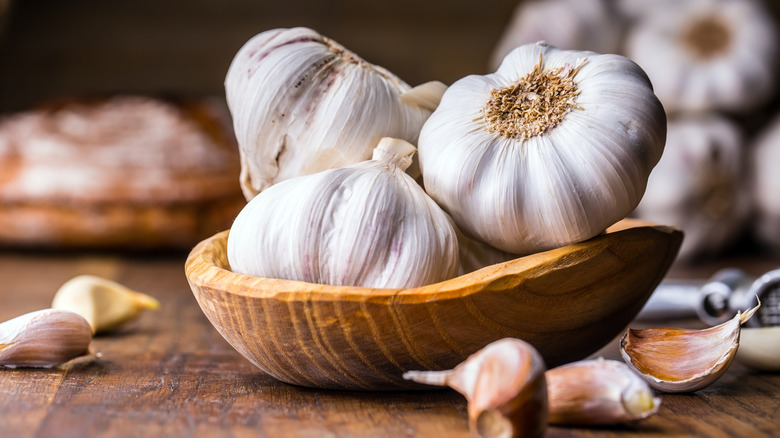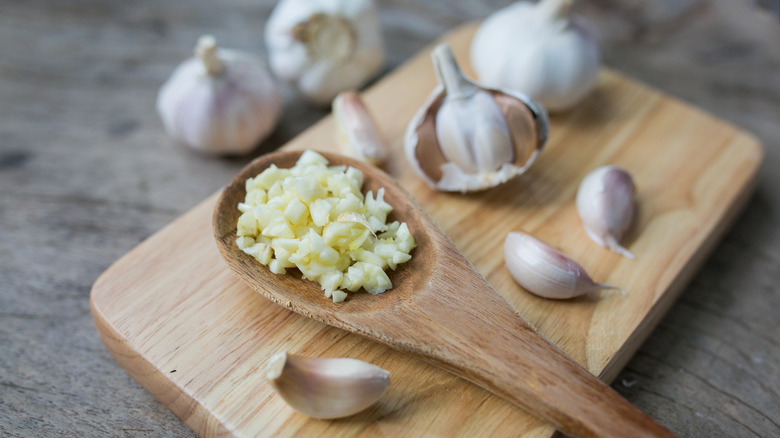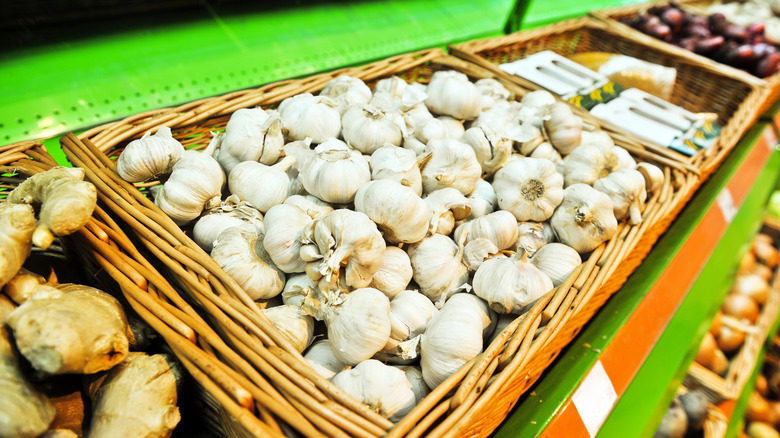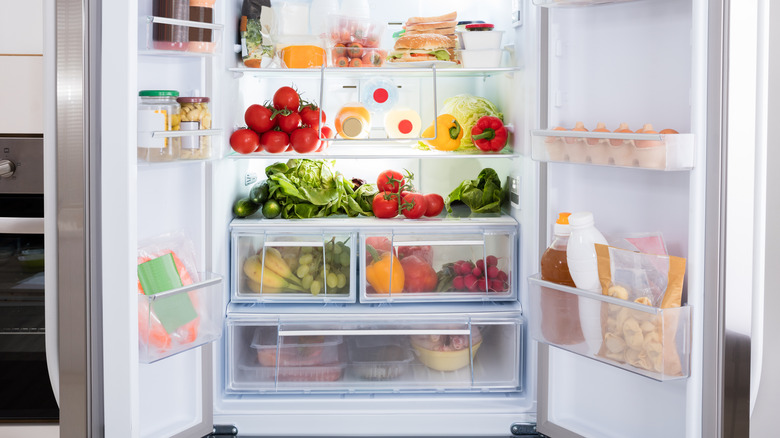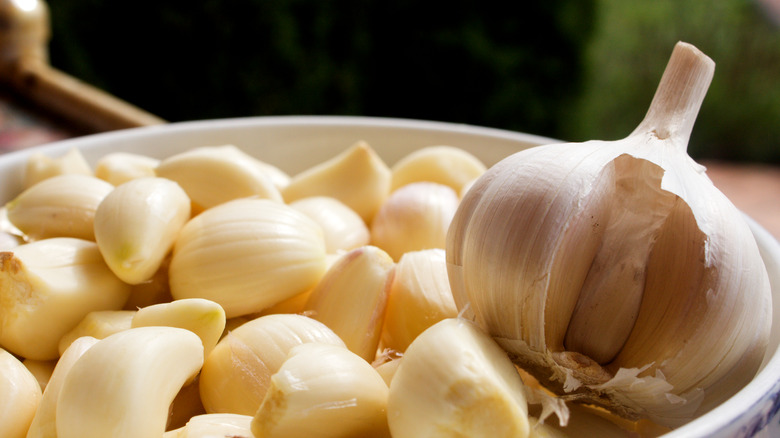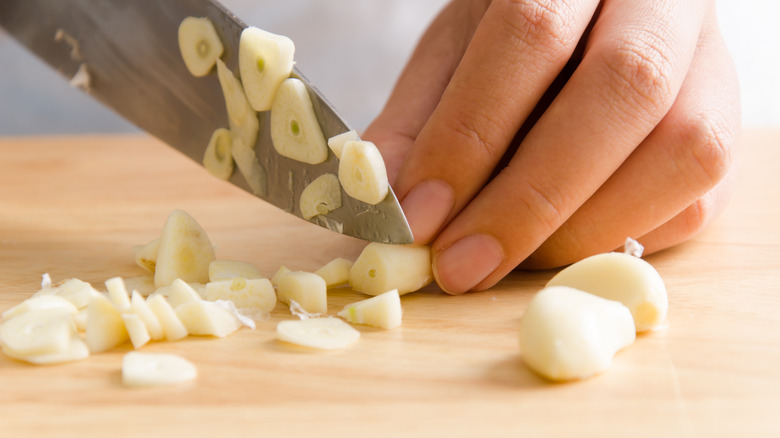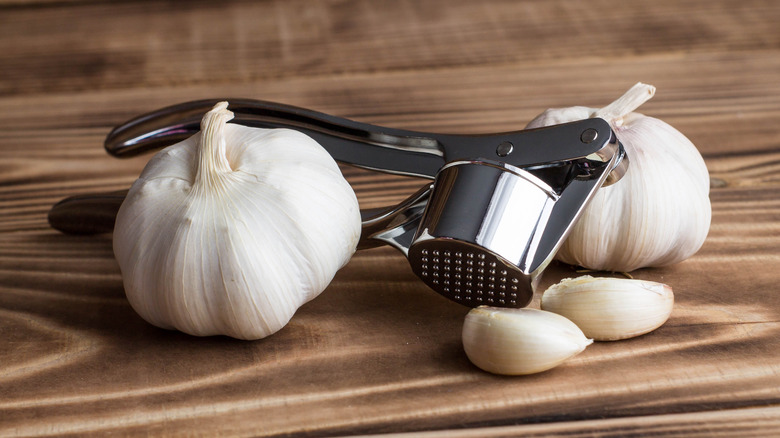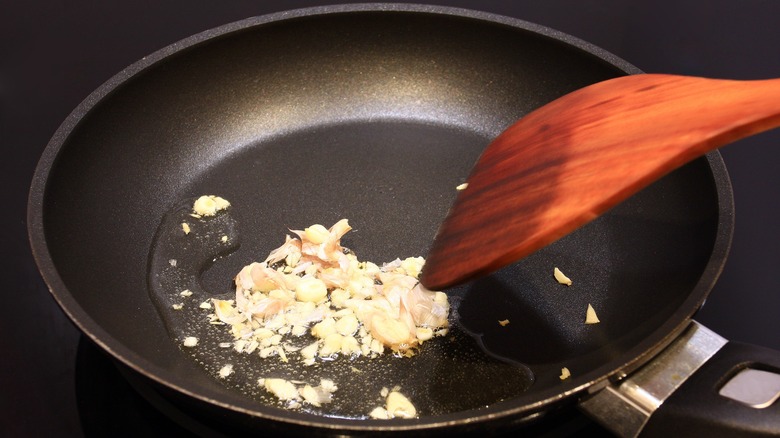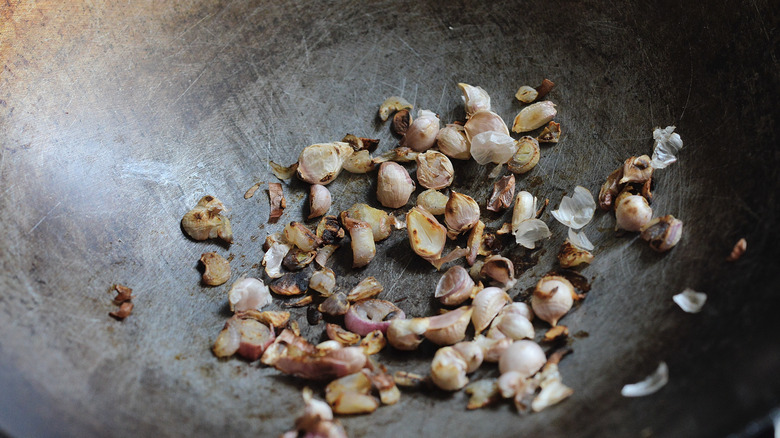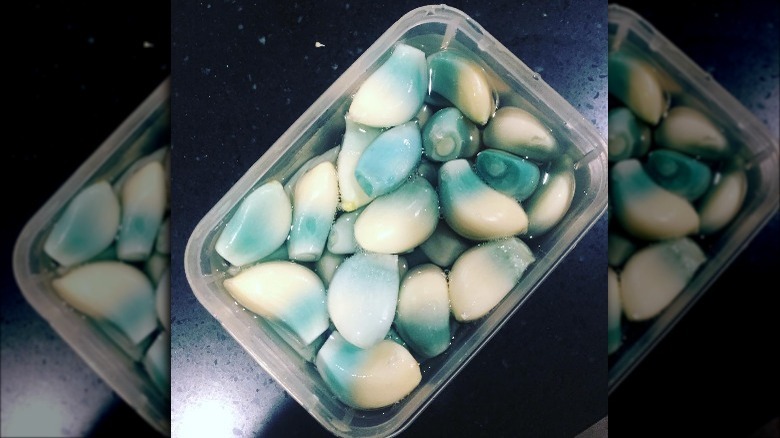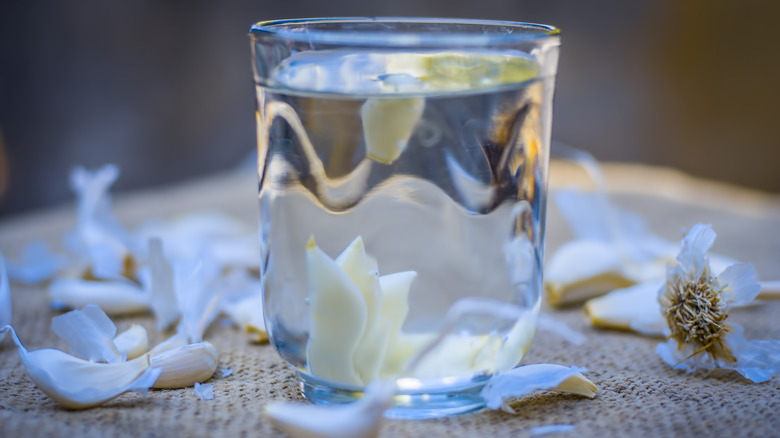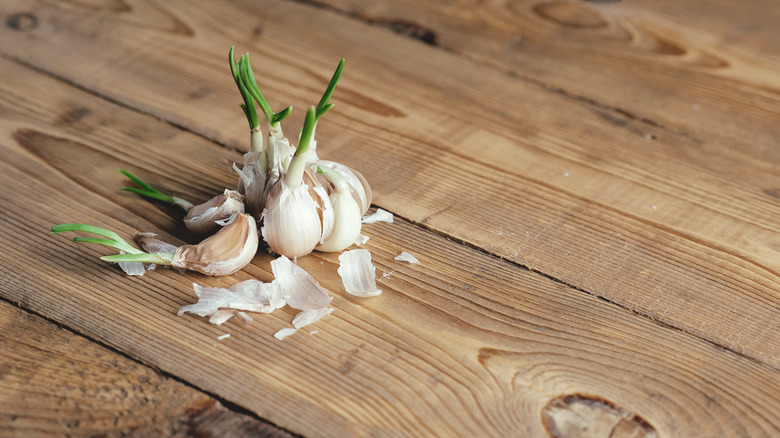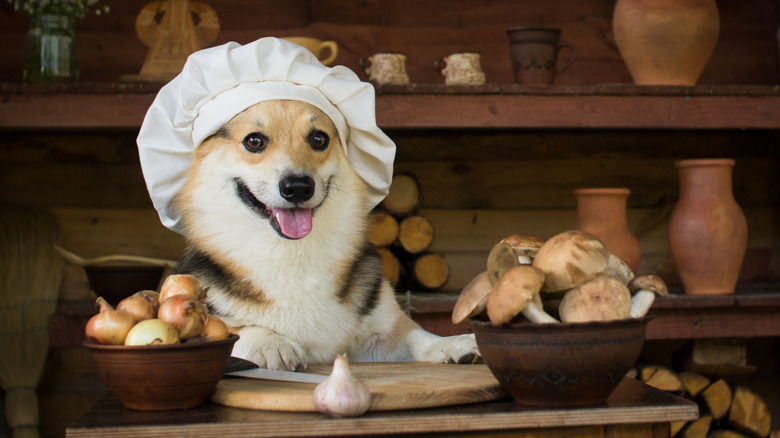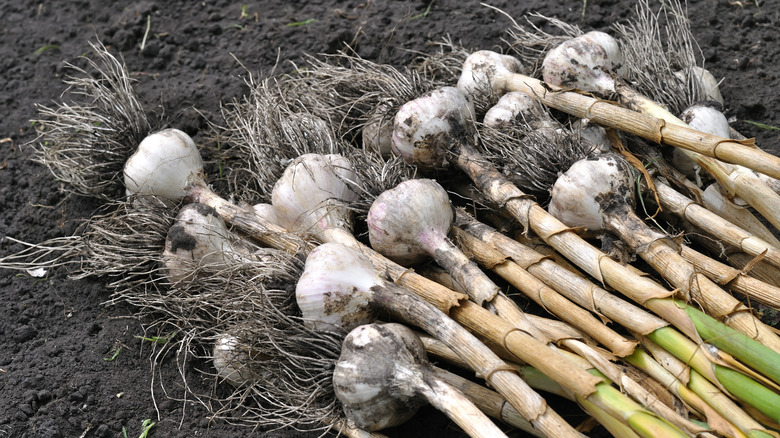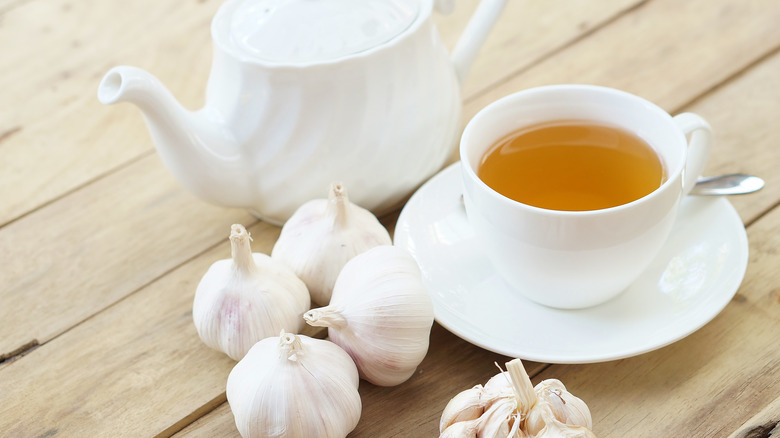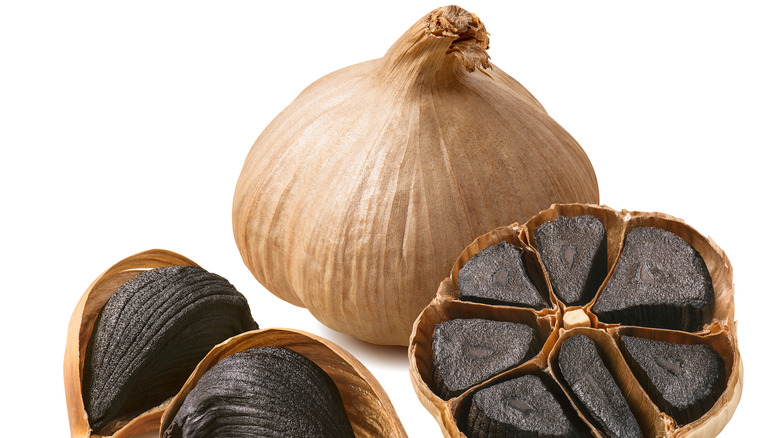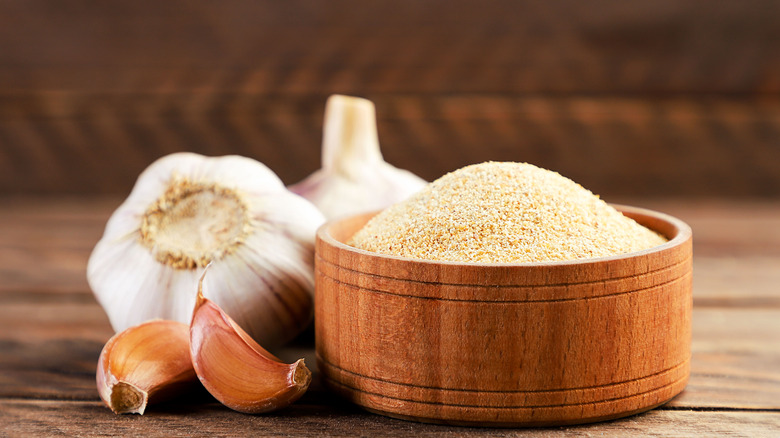The Biggest Mistakes Everyone Makes When Cooking With Garlic
Any cook worth their salt knows that garlic is the seasoning of the gods. Versatile, easy to use, and utterly delicious, you'd be hard-pressed to find a dish that wouldn't benefit from a dash of garlic. It's got a whole load of other uses too: It has medicinal properties, for example, and can combat illnesses such as the common cold. It can also be used as an anti-fatigue agent, turned into an adhesive to fix cracks in glass and, of course, hung up on your door to keep vampires away. The sky's the limit.
More than anything else, however, it's just a great thing to cook with. Unfortunately, although garlic is an incredibly hardy and useful kind of seasoning, it's not impossible to misuse it. In fact, there are plenty of different ways to get garlic wrong, and succumbing to any of these pitfalls could dampen its effect on your dish to the point that you might as well have never used it at all — and that's not fair on anyone, is it?
Buying it pre-minced
Let's start with the simple stuff: If you want to use garlic in the kitchen, use garlic. All that pre-minced stuff you find in jars at supermarkets and grocery stores is just going to steer you wrong. Garlic isn't the most exciting thing in the world to peel and chop, but putting yourself through the minor hassle of using actual, fresh garlic will pay dividends during the cooking process.
For one thing, you've got the fact that some research has shown that fresh garlic contains higher levels of allicin, an ingredient which prevents blood clots and bacterial infections. So if you're eating that stuff which comes pre-packaged and stewing in oil and water for weeks on end, you're not even going to be getting any of the amazing health benefits for which garlic is renowned. But if that's not enough to convince you to go fresh, take it from Anthony Bourdain.
"Misuse of garlic is a crime," he wrote in Kitchen Confidential: Adventures in the Culinary Underbelly. "Old garlic, burnt garlic, garlic cut too long ago, garlic that has been smashed through one of those abominations, the garlic press, are all disgusting. [...] Avoid at all costs that vile spew you see rotting in oil in screw-top jars. Too lazy to peel fresh? You don't deserve to eat garlic."
Strong words, but it's hard to argue with them.
Getting the wrong garlic
If you're buying fresh garlic, make sure it's actually fresh. It's no good eschewing the jarred, pre-minced stuff if the actual bulbs you buy are rotten to the core.
According to Simon Richard, produce buyer for San Francisco's Bi-Rite Market, there are a few choice things to look out for to make sure you're getting the right stuff at the right time. "Local fresh garlic season," he told Epicurious, "runs from mid-summer through early fall. At other times of the year, the garlic you see in the store is probably coming out of storage."
No matter when you buy your garlic, however, it's always good to test what you've got to make sure it's not a dud. "Pick the bulb up," Richard says, "and give it a light squeeze to be sure none of the outside cloves are too soft or dry. It should feel firm and not hollow or dehydrated. Try to select bulbs that don't have the sprouts forming."
Basically, if it looks bad or feels bad, it's probably bad.
Storing it in the wrong place
Improperly storing garlic is probably one of the most common mistakes people make with it. But it's a crucial part of cooking with garlic, and making sure it's kept in the right place will mean it keeps its medicinal properties, its flavor, and its health benefits — not to mention helping it stay fresh for months on end.
New season garlic (the kind which is harvested in early summer) is a milder kind of garlic which is more easily digested and arguably more flavorful than dry garlic. This type needs to be refrigerated immediately and used within a week.
Dried garlic (the kind you're more likely to find at a grocery store) should be stored at room temperature in a dry, dark place with plenty of circulation. It can also be stored in a paper or mesh bag, as long as there's plenty of dry air around it to stop it from sprouting. Just keep it out of the refrigerator. As long as you do this, the garlic will keep for several months (although that time period decreases significantly once you've started to remove cloves from the bulb).
If you've already minced garlic, you should be able to keep it in an air-tight container in the refrigerator, but you still ought to use it as soon as possible. Finally, freezing is a huge no-no — it'll damage the garlic's flavor and its texture. Dry, dark, and airy; that's what you're going for.
Peeling it wrong
Peeling garlic is never fun. It's fiddly, sticky, and takes just long enough to constitute a real pain in the neck — but there's no need to let it become such a nightmare. For starters, there's no need to mess around trying to find a way to scratch off the skin. Nor do you need to cut off any more of the clove than just the top in order to more easily peel it — this is largely inefficient, and will waste as much time as it does garlic.
No, there are two simple ways you can peel a garlic clove. The first involves placing the clove on a chopping board, placing the flat side of a knife against it and pushing down with your hand. It will crush the garlic itself downwards and loosen the skin, allowing you to take it off with zero effort. The second method involves pulling apart all the cloves and placing them in a mason jar with the lid on. You then shake the jar as hard as you can for around 20 seconds, after which the cloves should have pretty much peeled themselves. Empty them out, separate the skin and the cloves, and you're left with a fully-peeled bulb of garlic. Trust us, you'll never look back.
Chopping it inconsistently
Chopping garlic isn't the most difficult process in the world — especially if you've got experience in the kitchen — but that doesn't mean it's not possible to make some errors while you're at it. Firstly, speed is good, since dawdling at chopping means the garlic could oxidize and become bitter in flavor. (Of course, it's worth remembering that at no point should you actually rush to chop garlic; knives are knives, after all).
The slices you cut from the clove should always be identically-sized. Keeping them consistent in thickness and length means that, should you use slices rather than diced garlic in your recipe, they'll be less likely to burn during cooking. When dicing, keep your hand steady, your knife under control, and make sure not to have any mismatched pieces once the clove has been diced. Each little piece of garlic will need to be the same size to keep it cooking consistently and prevent any from burning.
Buying a garlic press
Yeah, we get it. Buying a garlic press is a tempting idea. After all, what could possibly be wrong with a handy tool which crushes all your garlic into mush without any of the hassle of chopping and dicing? As it turns out, a lot.
One of the many, many problems with garlic presses is that mush. Garlic should never be chopped too fine and keeping the texture rough and well-defined makes all the difference in the finished dish. According to Serious Eats, chopping garlic is also better for delivering a more mellow flavor, whereas pressed garlic is more aggressive and intense. Finely pressed garlic can also burn easily, making them good to use in no-cook sauces but pretty much useless anywhere else. And then you've got the fact that the press itself can only be used to press garlic, meaning it takes up lots of valuable space in the kitchen for little reward. Finally, how much time are you really saving by pressing garlic? The whole process doesn't happen much quicker than a decent cook can chop up a clove. So why waste the money?
Adding it too early
So you think you're ready. You've gotten a nice bulb of fresh, seasonal garlic. You've stored it well. You've peeled it, diced it, recycled your garlic press responsibly, and now it's time to throw it in the pan. Right?
Wrong. Lower the garlic and step away from the pan — because, yes, adding garlic to a dish too soon can ruin the whole thing. Here's the thing: garlic burns really easily. Like, really, really easily. And chopping it into little pieces will make it cook (and burn) even more quickly. It's crucial that you don't add the garlic to the pan until at least half-way through the cooking process (in the case of stir-fries and sautés), or very soon before you add a liquid element (such as pasta sauce) to the pan, which will bring down the temperature and prevent burning. If in doubt, add the garlic later rather than sooner — it's always better to have it come out undercooked than overcooked. Besides, raw garlic is good for you, dontcha know?
Burning it
This should go without saying, too. Just as you should never throw garlic in the pan for long enough that it'll be allowed to burn, nor should you cook it on a high heat. Instead, you'd be best off starting at a low heat and gradually increasing as and when it's needed. If you cook garlic on a high heat immediately, it'll be too crispy and lacking in flavor by the time the pan has adjusted to the lower temperature. Keep an eye on the garlic and, once it begins to turn golden-brown, bring the heat down and add whatever's coming next in the recipe. Once the garlic is safe from the hot oil — sitting on a bed of vegetables, for example, or stirred into a sauce — then you'll be okay to turn the heat back up.
This rule goes when you're roasting in an oven, too, and it's probably best to keep the temperature below 375 F to keep the garlic tasty and soft.
Turning it blue
So far, the worst consequences of falling for any of these garlic traps could involve a lessening of flavor, a messy chopping board, or a burnt clove. These are all issues you'd probably expect to happen — but it'd be more alarming if you found your garlic turning blue or green.
It can happen, though. The sulfur contained in the garlic reacts with copper (which you might find in water, butter, or lemon juice) and, thanks to enzymes contained in the garlic, copper sulfate is formed and a blue-green hue appears as a result. If you heat garlic too slowly, use lots of butter or lemon juice, or refrigerate your garlic, this can end up happening — luckily, however, even blue garlic is safe to eat.
Green garlic can happen because of the chemical precursors contained in older garlic, and the shade of green you see in your garlic can actually indicate how intense the flavor is going to be. It can happen because you left your chopped garlic out for too long before cooking, because you cooked your garlic together with onions, or because you added acid to the recipe before the garlic. Green garlic isn't exactly a bad thing either, though. In some parts of the world, cooks actually emphasize the color of their garlic. In northern China, garlic is aged for months to create an intense, green pickle before being immersed in vinegar for a week.
Not blanching it
For some recipes, garlic needs to chill out a little. Considering it's got such an intense, powerful taste, raw garlic can be just a bit too much sometimes — but how do you utilize it in dishes which don't require cooking, such as salads, pesto, or hummus? By blanching it, of course.
In order to find the best way to mellow garlic, Cook's Illustrated conducted an experiment in which they tested four different methods of tempering its flavor: blanching in milk, blanching in water, microwaving, and toasting. That last idea didn't work out too well, since lightly toasting garlic only heats enough of the garlic to remove some of the allicin (which is the cause of garlic's sharp taste). Blanching in water and milk both proved equally effective, but microwaving beat them out purely for simplicity's sake. The method is simple: Microwave your cloves of garlic in a bowl for two to three minutes, or until they're warm to the touch — but don't allow them to cook. What you should end up with is garlic with a smoother taste that will go perfectly with cold dishes. Better than going raw and setting your mouth on fire, isn't it?
Keeping the germ
No, not "germs" — although they're probably best avoided, too. The germ we're talking about here is a little sprout attached to each clove of garlic which, although harmless, is unnecessary for cooking. In fact, you'll actually benefit from removing it during prep.
If the garlic you're using is young, the germ is pale and soft and has little impact on the taste of the garlic itself. When that garlic ages, however, the germ turns green and begins to taste bitter. Accidentally cook the germ of an old bulb of garlic and you're going to find yourself in a heap of bother.
That means that unless your garlic is very young, it's best to remove the germ if you're using it raw. If you're putting a lot of heat onto the garlic, however, a slightly green germ isn't going to cause you too much bother — just make sure it's cooked long enough to combat any bitterness that might occur. It's a minor inconvenience to take that germ out, but doing so will go a long way.
Using it at all
This is a painful one to bring up, but that doesn't make it any less true. Sometimes, the worst mistake you can make with garlic is using it at all. The plant's versatility means it's suitable for pretty much every savory dish ever created, but that doesn't mean it needs to be used. According to Feast columnist Anna Jones, overuse of garlic in modern cooking is a genuine problem.
"There's an overuse of garlic in cooking in general, and in vegetarian cooking especially," she said. "I like to keep some meals more gently flavored, so leave it out altogether. More subtle dishes don't need garlic, and that should be celebrated. [...] While garlic is an easy way to add [a big punch of flavor], seasoning, spice and citrus can all do it, too."
Chef Simon Rimmer suggests using alternatives to garlic. "Paprika!" he told The Guardian in 2019. "It's just the best bloody ingredient going for adding depth and body. And Marmite! It lends an incredibly rich, umami note to roast veg, or use it like a seasoning. [...] It's all about finding the right balance." Other garlic substitutes could include lemon juice, grated zest, balsamic, sherry vinegar, palm sugar, maple syrup, or honey.
Think carefully next time you find yourself picking up a clove of garlic to use in your next recipe — you might well decide that the best thing you can possibly do is put it back down again.
Not growing it yourself
Of course, seasoned garlic pros might have never made these mistakes — or, at the very least, are long past making them anymore. So where can you go once you've perfected the art of cooking with garlic? If that's the case, maybe it's time to give up buying garlic in the store. Planting and growing your own garlic can be an immensely rewarding experience, not to mention cost-effective and environmentally-friendly. If you do make the switch to home-growing, however, there are still a few mistakes you need to keep a lookout for.
You've got to plant it at the right time, for example. If you plant too early, the garlic shoots can rise too high and draw water from the clove, potentially killing it. A good rule of thumb is to plant garlic between Halloween and Thanksgiving. It's also important to make sure it's planted the right way up — garlic shoots grow from specific areas of the clove, and planting it upside-down will make the garlic work harder to get to the surface, which can cause problems when it comes to harvesting. Garlic requires deep planting, too (at least five inches deep) to mitigate the effects of freeze-thaw frost heaving during the winter.
These are only a few of the roadblocks you might run into when planting your own garlic, but they're all easily avoided if you know what you're doing. Get it right, however, and you'll never want to buy from a store again.
Boiling it for too long, or at all
It's easy to fall into the habit of boiling garlic in dishes: mashed potatoes, lentils, risotto. According to Livestrong, because boiling garlic removes some of its vitamin content, if you want to siphon all the nutrients you can, the best way to have it is raw. To get the most nutrients, you can sauté your garlic, set it aside, and add it at the end. Or, you can mince fresh garlic and add it once your other ingredients are cooked.
As delicious a flavor garlic is, crunching on a stray clove does not sound appetizing. That's why some people may turn to garlic water or tea as their elixir of choice. Per Better Me, when you absolutely must boil your garlic, the trick lies in the duration. So to make garlic water, you would add a few cloves to a cup of water and bring it to a boil, and then you must turn down your heat completely as soon as it starts boiling. Let it cool, and enjoy. Otherwise, you can make Dr. Lutzi's tonic: Fill ¼ of a glass jar with freshly chopped garlic, and the rest with apple cider vinegar and honey — in equal parts. Let the jar sit in a dark space for a week while giving it a quick daily shake, strain the garlic out, and have a tablespoon a day to give your immune system a boost (via Well + Good).
Not using black garlic
Surprised to learn that there's such a thing as black garlic? Welcome to the club! Now, you're likely wondering where it comes from and how it differs from regular garlic everybody knows. According to Black Garlic, it's unclear where and when it was first cultivated, though there are claims it originated in Asia. When it comes to differences, there are five distinct ones to note. Most notable is the color; you can make it black by wrapping regular fresh garlic in aluminum foil and letting it ferment over three to four weeks. The second and third are the odor and taste. Because it's fermented, black garlic smells milder than garlic, and while the taste is also mild, it's likened to a faintly bitter caramel. In terms of digestion and nutrition, black garlic is generally easier to digest, while the nutrient profile is bolstered with more phenols post-fermentation.
Per Well + Good, some of the health benefits you can reap from this include improved insulin resistance, a load of antioxidants, improve heart, liver, and brain health, and even some cancer-fighting agents. Although black garlic does lower amounts of allicin — the stuff that holds some of regular garlic's health benefits — it does have higher amounts of S-Allylcysteine which assists the body in absorbing allicin. This means what it lacks in amount, it makes up for by helping the body absorb those health benefits that regular garlic offers, more efficiently (via Nourish by WebMD).
Assuming powdered garlic is inferior to raw garlic
For all the talk about fresh, raw garlic as the best way to consume garlic, one could assume that powdered garlic pales in comparison. However, even though the assumption could easily follow that powdered garlic is a synthetic form of garlic, per The Washington Post, it's so natural that you can actually make it at home; even your store-bought garlic powder should have no other ingredients but garlic. When would you use it instead of fresh garlic? It's perfect for marinades, spice rubs, or dredges that need all flavors to be well spread out. It's also great as a last-minute addition when you've already cooked a sauce with fresh garlic but want to add a little more of its flavor at a later serving. Lastly, given how easily garlic burns, garlic powder is a wonderful alternative when you have to keep your food on the heat for a long period of time.
If you are inclined to make it yourself, all you need to do is very thinly slice three heads of garlic, dehydrate them at 125 F until crispy (or air dry them if you don't have a dehydrator), ensure there are no soft bits, and give them a blitz in a coffee or spice grinder (via Slate). This should yield ⅓ cup of garlic powder. If you're still skeptical of just how good powdered garlic can be, you can take it one step further; activate it with water.
